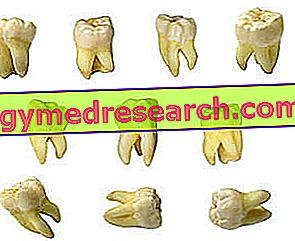Premise
After the extraction of a tooth, the patient's speed of recovery is heavily conditioned by the complexity of the intervention and by the compliance with some precautionary rules, which are very important to reduce the risk of complications.

Risks after a tooth extraction
Whether it is a wisdom tooth or a canine, it matters little: the risks that occur after the extraction of a tooth are almost the same.
First of all it is good to remember that a healthy tooth requiring extraction for reasons of misalignment or dental malocclusion - typical wisdom teeth condition - faces fewer dangers or post-surgery complications than a tooth severely damaged by deep caries, pulpits, granulomas, dental abscesses or whatever. Also possible morbid conditions can heavily affect the post-dental extraction course: patients affected by systemic pathologies (eg diabetes, autoimmune diseases, chronic renal failure etc.), as well as subjects undergoing chemo / radiotherapy or who have to take corticosteroid drugs, can present considerable recovery difficulties after the extraction of a tooth.
Inevitably, after the avulsion of a tooth, the patient experiences an unpleasant sensation of swelling and gum pain, often accompanied by a slight bleeding which should resolve within the 24 hours following the operation. Within certain limits, these side effects can be defined as "normal". Let us remember that, although it is relatively simple, dental avulsion always remains a surgical operation in all respects, so it is understandable how the organism can react after the forced "removal" of an integral part of the body.
If the general rules of post-extraction prophylaxis are not respected, the clinical profile of the patient can dangerously degenerate. In this sense, the most worrying post-surgery complications are dental infections such as:
- Alveolite: alveolus infection (the bone cavity where the tooth roots are housed)
- Dental abscess: accumulation of bacteria, white blood cells, plasma and cellular debris (pus) confined to the tissues surrounding a tooth
- Dental granuloma: chronic inflammation of the root apex and surrounding tissues
- Dental cyst: rounded cavities that progressively expand in the bone, destroying it. This is a typical complication after extraction of an included wisdom tooth
Among the possible complications resulting from dental extraction we must not forget the temporary loss of sensitivity of the lip and tongue to the side where the operation was performed.
Prevent dental infections
Before a tooth is extracted, the doctor or specialist surgeon must communicate to the patient all the risks and complications that could cause such an intervention. As mentioned several times, compliance with the advice suggested by the doctor and the observance of certain oral hygiene rules can undoubtedly help to minimize the risk of acute pain, infections or other post-extraction complications. In the table, some general suggestions are summarized.
What to do after a tooth extraction ... | Tips |
... to prevent pain after the first 24 hours after dental extraction |
|
... to prevent or limit bleeding immediately after tooth extraction |
|
... to prevent pain in the days following extraction |
|
... prevent infections |
|
... promote recovery and speed up healing |
|
... if the pain persists |
|
... if the bleeding does not stop |
|
... in the presence of fever |
|
Diet: what to eat and what to avoid
Also nutrition influences the recovery of the patient subjected to a tooth extraction. In fact, after the operation, it is strongly recommended to follow a light, balanced and water-rich diet. In particular, in the 24-36 hours following avulsion, we suggest a mainly liquid or semi-solid diet, therefore consisting of soft foods such as mashed potatoes, lukewarm soups, lukewarm soups, smoothies, minced or pureed meat, baby food, puddings, meatballs, fish boiled etc .. The residues of solid food, in fact, tend to get stuck in the sores on the gum - still painful and not completely healed - left by the intervention. Caging in these wounds, the bacteria, fond of carbohydrates and food, wedge into the injured gingiva, giving rise to a series of even serious dental infections.
In conclusion, it is good to reiterate that the observance of these precious suggestions is extremely important for the purposes of prophylaxis against infections or complications after a dental extraction intervention.



